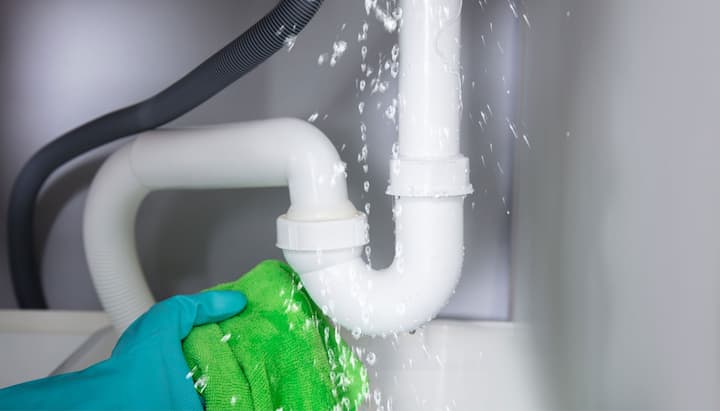
Top Water Damage Prevention Tips
Water damage prevention is a vital and necessary part of home ownership. A few simple steps can help to protect a home from potential water damage and the costly water damage repairs that it may require. Taking proactive steps toward identifying potential sources of water damage can save homeowners time and money in the long run.
Uncover potential causes to avoid water damage
The notion that water damage only occurs due to heavy rain, overflowing rivers, and coastal flooding is not necessarily true. The most common source of water damage is the plumbing system. Leaky faucets and showerheads, faulty washing machine hoses and clogged drains are all potential causes of unwanted moisture in the home. Regularly checking for leaks or corrosion in these areas can help mitigate future issues. Additionally, inspecting appliances such as dishwashers and refrigerators for leakage signs should be done regularly.
Another significant contributor to water damage is the home’s foundation. Over time, foundations may shift and crack due to natural settling or soil movement which can lead to seepage through basements or crawl spaces. To protect against this type of issue, it is important to regularly check for cracks in concrete walls and moisture buildup inside these areas. Making sure gutters and downspouts are clear from debris will also reduce the risk of foundation problems from heavy rains or snow melting near the house.
Regular home maintenance
Having identified potential sources of water damage, it is important to reduce damage risk quickly. The first step in reducing water damage repair risk is ensuring that all gutters and downspouts are in proper condition, clear of debris and firmly attached to the house. Another key measure in preventing water damage is monitoring plumbing systems throughout the house. In addition, checking for any visible signs of mold growth or wet spots on walls and ceilings should become part of regular home maintenance routines – this may indicate a hidden plumbing problem that needs attention.
Finally, regular inspections by a qualified plumber are recommended for aging plumbing systems to identify any potential issues before they cause significant damage. Early detection helps reduce water damage repair costs and minimize disruption caused by extensive repairs needed due to prolonged neglect. Taking proactive steps like these will help ensure home safety from costly water damage incidents in the future.
Control humidity levels
It is essential to maintain humidity levels to prevent water damage. To ensure indoor health and stability, humidity levels must be controlled. Humidity should be monitored regularly. A relative humidity of between 30% and 50% is ideal for indoor air quality. However, during the summer months when temperatures are higher, a lower percentage may be more suitable. A hygrometer or other device can be used to monitor humidity levels and make necessary adjustments.
When humidity becomes too high, installing a dehumidifier can remove excess moisture from the air. Keeping windows and doors closed when the weather is hot and humid outside will also help keep humidity levels low indoors. Additionally, using fans to circulate air throughout the home will allow for more efficient moisture evaporation from wet surfaces. By taking these steps, homeowners can ensure that their indoor environment remains safe and free of water damage caused by elevated humidity levels.
Choose building materials that match your climate
When selecting building materials for a home or business, it is essential to choose materials well suited to the local environment and climate. This will help minimize water damage risk due to rain, storms, floods, and other weather-related catastrophes. Furthermore, choosing materials that are resistant to moisture will reduce the chances of mold growth and other water-related issues.
Wood is one of the most popular building materials for homes and businesses because it is aesthetically pleasing, relatively inexpensive, and easy to work with. However, wood can suffer water damage if not properly sealed. Therefore, when using wood for structural elements such as framing walls or roofs, it is important to use pressure-treated wood or another type of wood treated with sealants against moisture. By selecting appropriate building materials and ensuring they are properly maintained throughout the years, homeowners can greatly reduce their risk of water damage in their homes or businesses.
Hire professional water damage repair experts
Having discussed the importance of choosing the right building materials, it is now time to consider the next step in water damage prevention – professional inspection and maintenance. This is arguably one of the most important steps for homeowners and business owners alike, as it can mean the difference between disaster and success. By having a professional water damage repair expert inspect your property regularly, you can ensure that any potential issues are caught before they become unmanageable.
By investing in regular inspection and maintenance services, you protect yourself from costly repairs and/or replacements down the line. It also helps you catch any issues early so that they can be addressed promptly and do not lead to more significant problems in the future. That is why professional inspection and maintenance should always form part of any comprehensive water damage prevention plan.
Choose Iredell County Restoration Pros for your water damage repair needs
It is estimated that over 98% of basements will experience water intrusion or flooding at some point. This statistic highlights the importance of proactive water damage prevention. Call Iredell County Restoration Specialists in Mooresville today for your water damage repair needs!